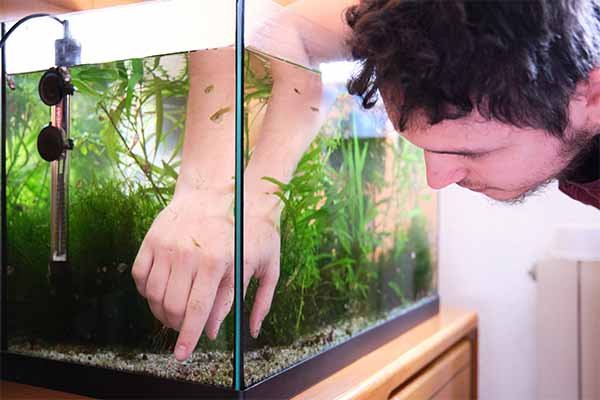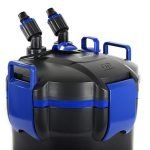How To Change The Aquarium Filter Without Losing Bacteria? | 5-Easy Steps To Follow, Get The Higher Result

You’ll have to ensure that the bacteria present in the filter media that you have previously used are able to colonize the new cartridge or filter media before putting it into the tank. So how do you replace the filter media in your aquarium, cartridge, or the entire unit without losing the beneficial bacteria? How to change the aquarium filter without losing Bacteria?
Bacteria and microorganisms always manage to put us on high alert. However, they do not always cause the harm we believe they do. Especially not if we are using them for our benefit. But not all of us are aware of the beneficial side of bacteria.
One of the highlights of beneficial bacteria is that they are essential to maintaining good aquarium health. But sometimes, because of a lack of knowledge, many aquarium owners either kill or lose these beneficial bacteria and end up risking the lives of the fish.
One of the most common mistakes aquarists make is mistakenly getting rid of the bacteria while changing the filter or filter cartridges. It’s important for all tank owners to know how to avoid bacteria loss while replacing filters and cartridges. So, how to change the aquarium filter without losing bacteria?
Let’s find out all about losing bacteria and how to avoid it while changing the aquarium filter.
Why Are Bacteria Needed In The Aquarium?
Bacteria are essential for biological filtration. There is a way of filtering aquarium water with the help of bacteria that maintains the tank’s health. The good bacteria that develops on the filter and cartridge of your filter over time is in charge of running the tank’s major waste disposal mechanism.
Ammonia is released into the
As previously stated, ammonia decomposes into nitrites and subsequently nitrates, which lessens its toxicity. During a routine water change, these nitrates are removed from the water. So, in this way, the biological filtration system serves to keep the tank balanced and healthy.
How To Change The Aquarium Filter Without Losing Bacteria?
There are various ways of changing filters without losing the bacteria. You might ask, how to change an aquarium filter cartridge without losing bacteria?
Let me assure you that both are the same. You just have to avoid suddenly changing a filter or filter cartridge and do a few tricks. Here are some of the ways you can safely change a filter without losing any bacteria:
1. Keeping The Old Filter
If you’re replacing your tank’s whole filter system, leave both the old and new water filters inside the tank till the beneficial bacteria colonies have a chance to inhabit the new filter. Because
- This two-filter setup is brief.
- Simple to put up.
- And incredibly effective.
- You will be capable of making a move with virtually little bacteria loss if you leave the original filter while operating the new filtration system for approximately 4 to 6 weeks.
It may not be the fastest way to replace a filter without contaminating the water. Even so, when moving to a completely new filtration system, it is unquestionably the most cost-effective technique.
Note: It is, nevertheless, vital that you keep a close eye on the water flow here. The high flow will undoubtedly disrupt the fish, especially the young and little ones. Fishes are more stressed when the flow rate is high because they continuously battle against the water flow.
A modest flow rate (you can use an aquarium wavemaker) is beneficial to the fish and the living plants since it helps sustain a healthy CO2 level (fish tank co2 booster). If necessary, filtration pads can be utilized to lower the rate of flow.
2. Repurpose The Old Filter Material
If maintaining two filtering devices in the aquarium isn’t an option for you, the best solution is to repurpose the filter media from the previous filter in a new one.
- This will function best if both the filtration systems need compatible media.
- But if you’re dealing with filter cartridges of updated versions or different brands, this could be a little more difficult for you.
As mentioned before, you can keep the previous filter cartridge inside the new filter for 4–6 weeks if it is in good condition. The new filter may not perform to its full ability throughout this time as the previous cartridge is still there, but it will tremendously enhance your tank’s bacteria population.
This strategy allows bacteria to settle and flourish in the new water filter, reducing the chance of your tank experiencing any negative impact from a filter replacement. A significant loss of bacteria combined with an unprepared filtration system can cause chaos. That is why delaying the placement of a new filter for a few weeks is worth it.
3. Using Tank’s Water For Filtration Maintenance
This filtration maintenance step focuses on cleaning rather than replacing filter material. Because it’s a necessary step if you are keeping your old filter in the tank with the new one, skipping this novice fishkeeping error might cost you many beneficial bacteria or even, in the worst-case scenarios, the lives of a few pet fish.
What you need to do is:
- Always gently clean the filter media in the old tank water but clean it outside the tank. The purpose of cleaning the filtration media is to eliminate clogged debris and dirt.
- Denitrification bacteria aren’t supposed to be cleaned or eliminated. Only a simple dip in chlorinated water from the tap can ruin the bacterial culture. So, at all costs, avoid any rinse or dip in chlorinated water.
- Bacteria are the cleaning crew of your aquarium, so when washing filter media, what you have to do is make sure water can travel into it during filtering.
4. Replacing Half The Sponge Filter
Filters work by capturing waste and dissolved substances while they are being circulated. The filtration system that water travels through can ultimately become clogged, preventing the filtration system from performing properly if the water is too unclean. In some of these cases of filters working improperly, you need to replace your filtration system.
But how do you know when your filter needs replacement? Well, if you’re using a sponge filter and you see that the sponge isn’t springing back to the original shape, it’s a sign that you have to replace the sponge in the filter. What you should be doing is:
- If your filtering media has two sponges, you should only replace one and keep the other one in the filter.
- If you have one filter sponge, then you need to split that one in half. You have kept half of the old sponge and paired it with half of the new sponge.
This method gives the bacteria that have already developed themselves in the sponge an opportunity to inhabit the newly installed sponge. One used or half-used sponge contains enough beneficial bacteria to keep the water condition in the aquarium from deteriorating.
5. Three-Stage Filtering
With a three-stage filtration system, you can start changing the filter medium without fear of losing germs. This sort of filtration process usually includes the following components:
- Mechanical media consists of pre-filter coils and rings made of ceramic.
- Biological media consists of coarse or fine sponges.
- Chemical media consist of activated carbon.
Bacteria will develop and collect on this filtration media, allowing you to replace and clean each component individually without upsetting your aquarium’s bacterial colony. What you need to do is:
- Keep a record of which filtering media you previously changed before deciding whether to clean or replace it. Between those changes, bacteria have time to thrive on the new one.
- Allow at least 6 weeks for each component to grow and become covered in beneficial bacteria. This filtration system maintenance technique may necessitate some planning ahead of time, but it’s the best long-term option for bacterial preservation.
- Do not hesitate to cleanse the filter if there is a sudden rise in waste or dirt blocking it and impairing the flow of water/oxygen. Because nitrifying bacteria may have landed initially in the filter, it isn’t the sole area in the aquarium where they’re flourishing.
Checking Bacteria Level After Cleaning Filter Cartridge
There is no simple test to determine whether aquarium bacteria are mixed with water and whether they perform good or bad functions in your aquarium. They’re also too microscopic to see without the help of anything.
However, testing the quality of the water in the tank daily can be helpful. Such as ammonia level, nitrite level, and nitrate level testing, as well as pH tests, can tell you whether your biological filtration is working or not. And that will tell you whether your tank’s water is building up too much ammonia or if the pH is incorrect. Then you will be able to understand:
- Whether the beneficial bacteria are there to do their job or not
- The amount of filtration they are doing tells you if your tank has enough beneficial bacterial colony
Frequently Asked Questions
Q: How often do I need to change my filter cartridge?
There is no time duration as to when you should change the filter cartridge unless it’s necessary. Many aquarium owners make the mistake of replacing the cartridges every time they perform routine maintenance. But if you notice that the cartridge is ripped, breaking apart, or is no longer usable, it is time to replace it.
Q: What substance will kill the beneficial bacteria in my tank?
One of the most dominant reasons is chlorine. Chlorine will kill beneficial bacteria. But these bacteria can also be killed by other toxins that ruin the biological filtration.
Q: How often do I put healthy bacteria in my tank?
Putting bacteria in the fish tank is just as important as adding new fish or changing the water. If you replace the water every 2 weeks, you’ll need to administer bacteria to it twice a month. So, in every two water changes, there is one addition of bacteria. Then the bacteria will be able to keep pace with the ammonia conversion.
Q: Can power outages kill bacteria?
Power outages can kill bacteria due to a lack of oxygen. Aerobic bacteria, such as nitrifying bacteria, require oxygen. More than a few hours in the absence of electricity will deprive your filter’s bacteria of oxygen. If a power outage lasts for a long time, test the water again to see if you need to add bacteria. [ Relevantly, You can read (1) How to increase oxygen in your aquarium & (2) How can I oxygenate my aquarium’s water without a pump? ]
Conclusion
The vast majority of novice aquarists are ignorant of the important role bacteria play in the tank. Even some are so anxious to improve their aquarium’s filter that they accidentally eliminate the majority of the good bacteria while changing the filter as they don’t know how to make it safe for the bacteria.
But now you know how to change the aquarium filter without losing bacteria. So you are safe from making that mistake. Also, to mention the obvious, don’t change the filter cartridge if it’s not needed.
Make sure to do the few tests on the water that are mentioned above and avoid chlorinated water. And with that, you are good to go.

